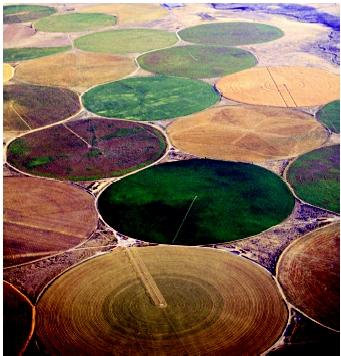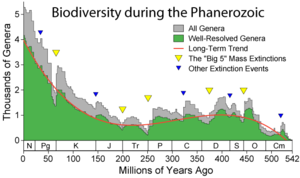First the Geosphere, then the Biosphere, now the Noosphere - this is the time-line of evolution. Initially was the emergence of the geosphere. It followed the biological evolution, which was leading to the consecutive development of cell-body-systems and body-mind-systems. Offspring of the latter were mind-culture-systems, societies. All these systems rely on processes to process information and to handle communication. So far the conceptual, generalizing layout, but how goes the storyline
To start off simple...
Initially, 10 billion years ago, stars formed of hydrogen only. Hydrogen is the most simple chemical element combining a single proton and a single electron. The initial stars fused in their cores hydrogen, the most simple chemical element, to more complex chemical elements such as carbon or iron. Now minerals could develop combining different chemical elements.
When these minerals aggregated to planets, like Earth several billion years ago, they evolve in a new fashion. Chemical process transform the minerals and eventually geochemistry of planets as well as geology of planets developed. Different chemical processes combine into process loops, and the Geosphere is forming. Different reservoirs of the Geosphere exchange matter and the matter flows in closed pathways repetitively through geochemical cycles.
Eventually, increasingly complex repetitive chemical processes developed. These processes get more complex than simple transformation of minerals in geochemical cycles. Special processes happen preferably at mineral surfaces. These surfaces provide geometrical shapes that ease the development of complex chemical structures including their replication. Eventually, replication of complex chemical structures was getting an abundant process on Earth some billion years ago. At that moment, Earth’s chemical processes had evolved to a stage "living beings" could emerge. Replication of structures is an essential, primary key feature of life. Eventually, the replication process led to reproduction. This happens once the replication process changed, and the replication process produced "more of about the same"
To get a bit evolved...
Initially the most simple "living beings" consist in closed boundary layers, which are segregating a bit of matter. The boundary layer encloses the replication process. The boundary layers segregate the "living beings" from each other and other matter. Boundary layers are further fundamental key-feature of "living beings" because they are interfaces that control interaction; interaction between different "living beings" and between them and their environment. These interactions include selected fluxes of matter and information across the boundary layer. This is the onset of biological evolution. Once the biological evolution covers the globe and feeds back into the chemical-geological evolution of the Earth, then the Biosphere is forming.
Controlled interaction of "living beings" ends when they die. Then the protecting boundary layer are breaking up. Therefore for a lasting, perennial existence of life "living beings" have to replicate before they die. Thus, survival of a species requires to self-replicate sufficiently often before breaking up. A "living being" may survive if the self-replication or reproduction process produces copies of it in sufficient quantity and quality.
These copies do not have to be perfect; just "a-bit-more-of-about-the-same" will do the job. The copies have to match to the environment. Reproduction is a "copy-and-paste-me-into-the-environment-process" that produces a "bit more of about the same". The slight variation of the replicated "living being", when compared to its ancestor, is essential for survival. It is a means to cope with environmental change.
Variation is intrinsic to any faulty replication process of a kind that produces “just about the same”. Accurate, faithful replication will hinder survival because of misfitting to an environment that has changed. On the other side, severe faulty replication would hinder survival because of loosing functionality of the “living being”. The trick for survival is to replicate in high quantity and each replication being a slight variation. Biological evolution has to followed that approach. Evolution traced a path muddling through a wide range of possible changes.
Knowing about the environment is the key-strategy to find this path; a very successful strategy indeed, as evolution showed. It has lead to the development of receptors, sensors, signalling systems, nervous systems, and eventually brains, minds and culture. All these different features of living beings have in common that they are means to capture and process information about the environment with the purpose to better manage the exchange processes with the environment. In the end, it leads to getting a better control of the various exchanges processes in support of survival through reproduction.
To add a bit of complexity...
Evolved brains, thus very complex nervous systems are carriers of minds, or intelligence - initially very simple with limited skills. Minds have emerged as a new feature in course of the evolution of "living beings" once the complexity of their nervous systems had increased sufficiently. Minds are internal, virtual representations of the outer world, the environment around the "living beings". The brain holds these representations; thus it is the carrier of the mind.
The information about the external environment, which is hold in the mind, results from inputs captured by the receptors and interpreted by sensors. These inputs trigger signals. The nervous system transmits these signals. The brain processes theses signals. A mental object forms. Eventually a previous representation of the outer world in the mind, or mental object, modifies, and the mind perceives the external environment differently. These perceptions are internal to the “living being”, are virtual, and are mental objects. They are formed from heavily processed signals. This internal, virtual mental objects may be a distorted image of the external world. The mental object may evolve due to intrinsic processes of the brain, getting disparate from a faithful representation of the external environment. Nevertheless these virtual mental objects are significant drivers for the “living being”. Some hundred million years ago these drivers were a new feature produced by the evolution. Mind-setting was the new game to play for survival and reproduction. Even further evolved minds include also an internal, virtual representation of its carrier, the "living being". This particular mental object has the purpose to steer, manipulate, plan etc. actions of the carrier in the external environment.
Nervous system including the brain and the mind find their analogy in the computer hardware and the computer software. The hardware is the carrier to run the software. Hardware and software have to match for essential features otherwise the software does not function. The brain, the nervous system, and the body are the hardware on which the software, the mind, runs. The essential characteristics of the brain determine the manner how the mind functions. However, beyond the matching of essential features, a variety of minds can be carried by the same brain or nervous system. The essential function of the system "body-mind" is the same as in earlier stages of the evolution. Namely, to replicate the “living being”, and that in a quality and quantity which is at least “a bit more of about the same”. Thus, to survive as a species the body and the mind have to evolve jointly.
Evolution of minds opens options for cooperation and bonding between individuals. Individuals are similar but not identical body-mind-systems. The evolution of the bonded individuals or groups leads to sharing of know-how and ultimately to the emergence of craftsmanship, arts, culture and technology as new features of the external environment. The individuals act coordinated as groups, networks or societies shaping the environment in which, in order to survive, they have to reproduce in a quality and quantity that is at least “a bit more of about the same”; the Noosphere is getting established.
On the way out...
Much has happened since stars lighted up. Today, the number of human beings and their manner of reproduction are such that we squeeze the biosphere of planet Earth. The combined strength of humans is such that we shape the Geosphere of planet Earth starting the Anthropocene. Where do we go from here? Evolution will continue on its path building complex systems using simple building blocks. We will evolve beyond us. Increasingly complex technologies will open development paths to new self-replicating systems that differ from the the body-mind-systems as we know them today. These systems will reproduce themselves “about the same”, will carry internal representations of their own structures and their environment, and these beings will belong with us, as part of us to the Noosphere..
P.s......if we do not crash this planet
update 27th October 2013































